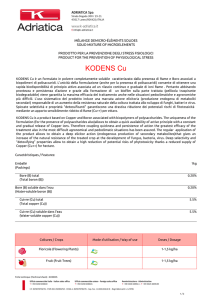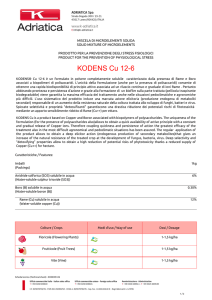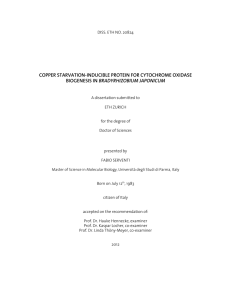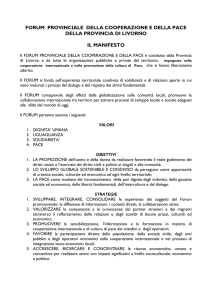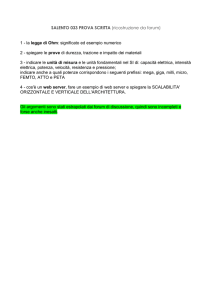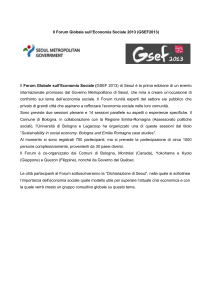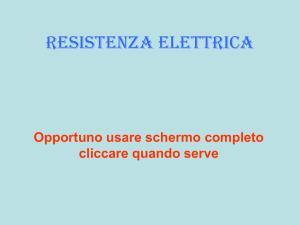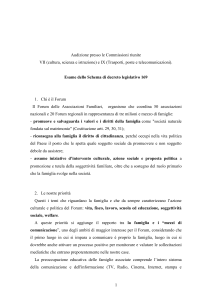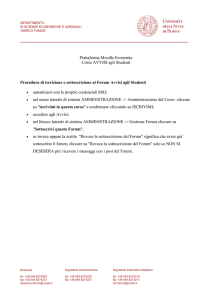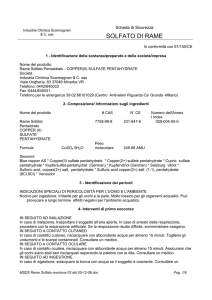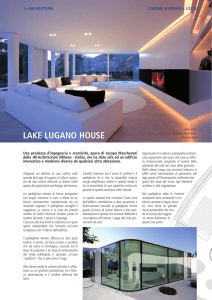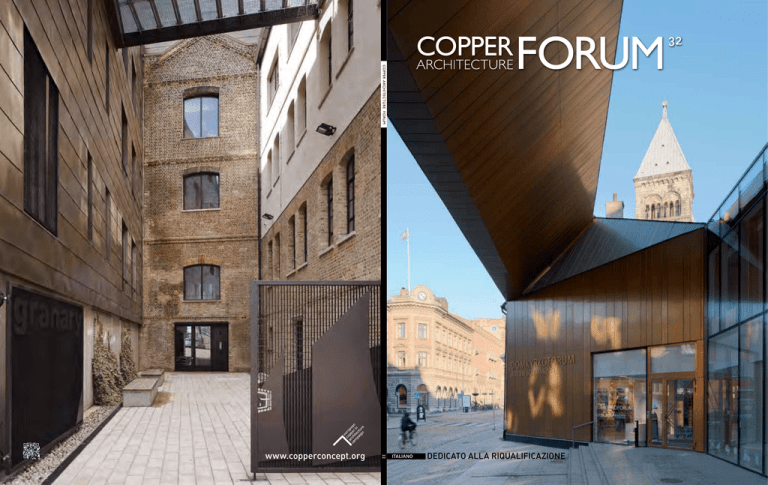
COPPER Architecture FORUM
32
www.copperconcept.org
Dedicato alla riqualificazione
EDITORIALE
Dedicato alla riqualificazione
Copper Architecture Forum 33
New Initiatives from
Copper in Architecture
Russia
Belgium
Czech Republic
Denmark
Finland
France
Czech Republic • Denmark
Spain
Sweden
Switzerland
UK
Greece
Germany
Holland
Hungary
Inspirational architecture
Italy
and design with copper from:
Luxemburg
Norway
Poland
Austria • Belgium
Russia
Spain
Sweden
Czech Republic • Denmark
Switzerland
UK
Finland • France
Greece • Germany
Holland • Hungary
I ture from
UMitec
ORArch
KU PAR IFO
TIDNING FÖR BYGGBRANSCHEN OM KOPPAR I
EHTI KUPARIN
AIKAKAUSL
KÄYTÖSTÄ
OLLISUUDES
AKENNUSTE
SA• 24/2008
Austria
• Belgiu
m
Czech Repub
lic • Denm
Finland
ark
lehti
FO OR UM
kuparis
ta arkkite
htuuris
sa • 28
/20
I
10
Obytný komplex
Frederikskaj v Kodani
Russia • Spain
• Hungary
Nová měděná střecha
pro katedrálu v Roskilde
Sweden • Switzerland
Italy • Luxem
burg
Norway
KU PA RI
Norway • Poland
any
Holland
Greece • Germany
Holland • Hungary
Italy • Luxemburg
• Franc
e
Greece
• Germ
Accordia – britský
bytový komplex
United Kingdom
• Polan
d
Sportovní hala v Budapešti
Russia
Italy • Luxemburg
• Spain
www.copperconcept.org
Sweden
Norway • Poland
• Switzerland
26
United Kingd
om
Russia • Spain
Sweden • Switzerland
www.co
pperconc
ept.org
United Kingdom
8 Transparenta inskriptioner i Lettland – 10 Treklöver i koppar
22 Cipea Villa Nanjing i Kina – 26 En flytande bronstrapp – 36 Dipoli, en modern klassiker
www.copperconcept.org
Finland • France
2 9/20 10
minassa
ri Kööpenha
pääkontto
eskus
n juutalaisk
Nordin uusi
GN Store
skus
voittaja: Müncheni
vierailuke
Copper Awardin kansallispuiston uusi
Unkarin
Aggtec –
KAUNIS
KoKo VUoSIS
28
Contattaci subito. Noi abbiamo bisogno di sentire da te sia i commenti su Copper Architecture Forum, sia i suggerimenti
per i progetti o gli argomenti che possiamo coprire in futuro. Basta inviare una e-mail alla redazione o al collaboratore
locale elencato qui sopra.
Č ASOPIS O MĚDI A JE JÍM V YUŽITÍ VE STAVEBNIC T VÍ • 26/2009
Austria • Belgium
Poland
FOORUMI
www.copperconcept.org
ˇ
FÓRUM O MEDI
Italy
Norway
KUPARI
© Copper Architecture Forum 2012
Architecture
from
Holland
Hungary
24
Copertina: Il Centro visitatori
della cattedrale di Lund (p. 4-7).
Foto: Åke E:son Lindman
Ultima di copertina:
Il Granaio, Londra (p. 12-15).
Foto: Tim Crocker
[email protected]
[email protected]
[email protected]
[email protected]
[email protected]
[email protected]
[email protected]
[email protected]
[email protected]
[email protected]
[email protected]
France
Greece
Germany
Luxemburg
MI
Stampa: Strålins Grafiska AB 2012, Sweden
IN ARCHITETT
KUPARIFOORU
Layout e produzione tecnica: Naula Grafisk Design, Sweden
DEL RAME
Austria
oNKo KUPAR
ADAN –
TAI PIDEM
PÄÄNK
VUoDEN
IN • KUPAR
2009
I INSPIR
IARKKITEHTU KUPARIPALKI
oI • KUPAR
NNoN VoITTA
URI KESTÄ
I oSUI KULTA
JA • ISLAND
VÄÄ? •
SUoNE
HAKAN
CoPPER
EN
IEMENRANTA
6 – KUNNo
STUSPRoJEK
T
• an architect-focused website copperconcept – with a substantial and rapidly growing project gallery.
• a pan-European architectural awards programme – the latest,
15th iteration attracting 66 entries of a particularly high standard.
• Copper Architecture Forum magazine – with a circulation of over 25,000 throughout Europe and beyond.
Editore: Nigel Cotton, ECI
LA RIVISTA
Finland
30
Indirizzo: CAF, European Copper Institute,
Avenue de Tervueren 168 b-10, B-1150 Brussels, Belgium
Denmark
3 1/20 11
www.copperconcept.org
E-mail: [email protected]
3 0/20 11
Austria
Belgium
Czech Republic
URA I
COPPER ARChitECtuRE FORuM
Redazione: Lennart Engström, Ari Lammikko, Chris Hodson,
Hannele Kuusisto, Hermann Kersting, Robert Pinter, Irina Dumitrescu
DAS MAGAZIN FÜR KUPFER UND ARCHITEKTUR I
Copper Architecture Forum
with Architecture from
Forum
Copper Architecture from
with Architecture
The European Copper in Architecture Campaign was set up by panEuropean and local industry associations with the support of participating copper fabricators to promote copper and its alloys in architectural applications. It achieves this through various means, principally:
La Redazione
Collaboratori:
Birgit Schmitz, De
Kazimierz Zakrzewski, Pl
Marco Crespi, It
Nicholas Hay, UK
Nikolaos Vergopoulos, Gr
Nuno Diaz, Es
Olivier Tissot, Fr
Paul Becquevort, Benelux
Pia Voutilainen, Se, No, Fi, Dk
Robert Pintér, Hu, Cz, SVK
Vadim Ionov, Ru
Register now at www.copperconcept.org to make sure you
receive your copy of issue 33.
29
Copper Architecture Forum è parte della ”Campagna Europea sul Rame in
Architettura”. È pubblicato due volte all’anno e ha una tiratura di 25.000 copie. La rivista è distribuita agli architetti e professionisti del settore edilizio
in Belgio, Danimarca, Finlandia, Francia, Germania, Grecia, Italia, Norvegia,
Paesi Bassi, Polonia, Regno Unito, Repubblica Ceca, Russia, Spagna, Svezia,
Ucraina e Ungheria.
Shown here is a competition visual for The Museum of the History of
Polish Jews in Warsaw - but how will it look in reality? You can find
out in our next issue. The competition-winning design, by Architects
Lahdelma & Mahlamäki (working in conjunction with Kurylowic &
Associates in Poland) aims to create a ‘lantern in the park’. The design
features a layered facade design using pre-patinated copper in combination with glazing. The play of advanced LED lighting behind the
decorated glass on the green corrugated copper will play a key role in
this luminescence.
COPPER ARChitECtuRE FORuM
Copper Architecture Forum n. 32, aprile 2012
Project Preview
31
Il rapporto di edifici vecchi e nuovi collegati tra loro è esplorato anche
nella nuova aranciera di una casa di campagna (p. 8-11) nei Paesi Bassi.
Si tratta di un padiglione con una notevole superficie vetrata e un tetto
curvo realizzato in rame pre-patinato verde, che lo lega alla casa originale. Una posizione più letterale è presa nel nuovo impianto di trattamento
dell’acqua di Varsavia (p. 22-25) che si riferisce fortemente alle forme dei
tetti spioventi e delle finestre, curve alla loro sommità, dei suoi dintorni
risalenti al 19° secolo. Qui, il rame svolge un ruolo più tradizionale come
materiale di copertura. E consideriamo l’importanza del rame in forme
diverse - trasparente e modulato - per rigenerare scialbi edifici del 20° secolo (p. 16-17 e p. 30-31). Concludiamo come abbiamo iniziato, con un
altro esempio di un intervento del rame che ridisegna il contesto urbano
del suo ospite più vecchio - questa volta agli antichi bagni pubblici di
Thiene, in provincia di Vicenza (p. 36-38). Qui, a un edificio ridondante
è stata data nuova vita: un centro giovanile singolare, caratterizzato da
un organica integrazione di gusci di rame curvato.
Ci auguriamo che possiate apprezzare questo viaggio intorno a questi
progetti di ispirazione, in cui il rame funge da catalizzatore per un’architettura creativa e la riqualificazione urbana.
rconcept.org
ww w.coppe
I diversi progetti che esploriamo qui dimostrano diversi approcci a questa sfida e variano da aggiunte e interventi su strutture pre-esistenti, a
nuovi edifici che interagiscono con il vecchio per rimodellare aree urbane. Ma un filo comune attraversa tutti: le impareggiabili e numerose
possibilità offerte dal rame e dalle sue leghe per l‘espressione architettonica.
La nostra storia di copertina lo dimostra abilmente. Qui, forme rivestite in ottone si insinuano a loro modo nel tessuto urbano, definendo
nuove prospettive e una nuova messa a fuoco sulla Cattedrale di Lund.
Inizialmente luminose e moderne, le superfici in ottone saranno presto
scure e pacate, assumendo un fascino senza tempo. La stessa peculiarità
vale per gli interventi con rame pre-ossidato su una storica villa italiana
(p. 18-21), reindirizzando gli assi e la circolazione interna per adattarsi
alla nuova funzione dell‘edificio, un hotel.
La natura senza età e permanente del rame è ulteriormente rafforzata
dagli elementi in ottone, annessi ad un castello spagnolo (p. 34-35).
Qui, non vi è alcuna pretesa di riferimento letterale, ma un‘estetica
astratta totalmente in linea con i suoi resti di pietra massiccia. Questo
approccio ha paralleli con il rame chiaramente utilizzato per esprimere
gli ampliamenti moderni di una tradizionale casa di paese in Lussemburgo (p. 26-29). Su una scala più grande, la nuova estensione per un
With a change of direction, our next issue focuses on new-build copper projects and how they are achieved. Alongside comprehensive case
studies, including Copper in Detail working drawing and Close-up focus pages, we shall be discussing technical and topical issues – notably
the impact of “Building Information Modelling” (BIM) techniques on
architectural freedom.
FORuM
magazzino ristrutturato di Londra (p. 12-15) sfrutta un rivestimento in
bronzo per definire la sua massa decisamente contemporanea. In questo
caso, una forma senza compromessi riflette il profilo spiovente dell‘originale, creando una composizione unitaria. Un approccio chiave simile,
ma inferiore, viene manifestato con un ampliamento di una chiesa a
Londra (p. 32-33).
COPPER ARChitECtuRE
Questo numero è interamente dedicato alla genialità degli architetti
nel rigenerare gli ambienti nei quali viviamo e lavoriamo. Preservare
e cambiare gli edifici esistenti e i paesaggi urbani per adattarli a nuovi
utilizzi è sostenibile, fa risparmiare e rende al meglio le risorse disponibili. Ma porta con sé anche una sfida per i progettisti: sviluppare la loro
particolare interpretazione della storia e del contesto per il 21° secolo.
We are always looking for new ways to engage with architects and designers, particularly to find out about and publish inspirational designs
and projects. Now, we are introducing a number of new initiatives:
• Share your copper project – simply upload images and information yourself by following the instructions on the website.
• Copperconcept Newsletter – register now via the website for this short, emailed update and you could win an iPad.
• Copper and the Home Awards 2012 – seeking innovative and
inspirational design ideas for the home from furniture to fittings
and finishes, with categories for professional designers and students.
Register for the
Copperconcept newsletter
for a chance to win an
iPad 2!
Register for our NEWSLETTER in any
of the available 17 languages to find out
about the latest copper clad buildings
and for a chance to win an iPad 2.
All new registrations between
1 March and 30 June 2012
will be entered into a prize draw for an iPad 2.
The winner will be informed via e-mail.
More information on these and all our initiatives can be found
on the website – www.copperconcept.org
COPPER ARCHITECTURE FORUM 32/2012
39
Indice
32
4
8
12 18 16
2 Dedicato alla riqualificazione
– commento della redazione
4-7 Intervento Divino
– un nuovo centro visitatori per la Cattedrale di Lund, Svezia
8-11 Continuità del rame
– ridefinire l’Aranceria della casa di campagna, Paesi Bassi
12-15 Una fusione di vecchio e nuovo
- un moderno ampliamento in bronzo ringiovanisce un tradizionale
magazzino di Londra
16-17 Skyline di rame
– la riqualificazione di uno spazio inutilizzato sui tetti, nel centro di Helsinki.
22
18–21 Timeless Copper
– a copper-clad intervention restructures an Italian villa for new uses
22–25 Pure Water under Copper Roofs
– Warsaw’s new water plant refers to neighbouring 19th century buildings
26–29 Copper Cottage
26 30
– additions to a traditional Luxembourg house are expressed in modern forms
30–31 Box Top
– transforming a 1970s office building with a transparent copper skin
32–33 Copper for House on the Rock
32 34
– returning a 19th century London church to religious and community use
34–35 Timeless Brass
– simplicity and permanence define additions to an ancient Spanish castle
36–38 Urban Shell
– distinctive copper-clad forms redefine the urban role of a disused
36
bath house in Italy
39 Back to the Future
– new projects in our next issue and Copper Architecture news.
COPPER ARCHITECTURE FORUM 32/2012
3
INTERVENTO DIVINO
Un nuovo centro visitatori nella città svedese di Lund utilizza forme
sfaccettate rivestite in ottone per collegare tra loro edifici disuguali
e per rigenerare la piazza di fronte al Duomo del XII secolo.
di Chris Hodson
4
COPPER ARCHITECTURE FORUM 32/2012
Il progetto dell’architetto Carmen
– che termina con una finestra a
le proporzioni e le linee degli edifici
Izquierdo, sviluppato a partire da un
imbuto, che si protende simbolica-
esistenti. Il motto del progetto vinci-
progetto vincente di un concorso, è
mente verso le torri storiche.
tore era “Portal e Atrium” (“Portale
e atrio”) e le ambizioni della propos-
incentrato su un intervento profondamente contemporaneo con ottone
In aggiunta agli strati storici
ta originaria si sono evolute in un
e vetro, che si snoda tra numerosi
Carmen Izquierdo ha detto: “La vi-
programma completamente nuovo
edifici antichi, legandoli tra loro. Il
sione era quella di creare un edifi-
nel design finale”.
fronte sulla via Kyrkogatan incorpora
cio contemporaneo che aggiunge
una tettoia in ottone, che continua
un nuovo livello agli strati storici
semplicemente il piano del tetto
che compongono il centro di Lund. Il
dell’edificio adiacente, con un ingres-
nuovo edificio cerca di fondersi con
so dal cortile sotto. L’edificio con-
il paesaggio urbano in maniera
tinua verso via Kungsgatan, quindi si
naturale cogliendo
estende poi verso la cattedrale con
una forma espressiva – l’auditorium
Ottone ... un materiale naturale che
offre una ricca superficie vibrante, che si addolcisce con l’età
per fondersi con il paesaggio urbano
COPPER ARCHITECTURE FORUM 32/2012
5
Internamente, lo spazio dominante è la hall d’ingresso, servita
sia dalla piazza della cattedrale che dalla Kungsgatan. Con il
suo atrio a doppia altezza, è un luogo di incontro conviviale
utilizzato per ricevimenti, mostre e rinfreschi, sovrastato dagli
uffici al piano superiore. Qui, la solidità dei muri (i cui rilievi
sono stati ottenuti pressando assi di legno sul cemento fresco), contrasta con l’apertura creata da partizioni completamente di vetro. L’espressivo auditorium è concepito come uno
Installatore del rame: Malmö Plåtservice AB
spazio unico con la sua caratteristica finestra trapezoidale a
Rame: Nordic Brass
imbuto, che incornicia la vista sulle guglie della cattedrale
Foto: Åke E:son Lindman
Un ingresso per i visitatori:
”L’edificio - ha aggiunto Carmen Izquierdo - crea interessanti
spazi sequenziali esterni ed interni; sarà un ingresso per i visitatori della Cattedrale e un forum per studi di approfondimento e discussione. Il nuovo edificio ha un design semplice ma
espressivo che si concatena al paesaggio urbano circostante attraverso i suoi angoli e le sue pendenze. L’ottone è stato
scelto per la pelle esterna del nuovo edificio in quanto materiale naturale che offre una ricca superficie vibrante. Dal momento che il materiale si “addolcirà” col passare del tempo,
l’edificio si fonderà gradualmente con il paesaggio urbano.”
Nel suo nuovo, luminoso stato, l’edificio è certamente assertivo e richiede una risposta da parte dei visitatori. Ma, poiché
l’ottone si scurisce naturalmente nel corso dei primi anni, acquisirà una qualità più sottile, senza tempo. Le forme e il movimento della realizzazione in tutto il sito riescono a preservare importanti visuali storiche, creando nel contempo nuove
prospettive. Spazi pubblici più intimi e variati vengono creati
anche intorno e dentro il centro visitatori. Alla sua apertura
lo scorso anno, il vescovo Antje Jackelén ha giustamente descritto il nuovo edificio come ”l’abbraccio esteso del Duomo”.
6
Architetto: Carmen Izquierdo
COPPER ARCHITECTURE FORUM 32/2012
DEPOT
GROUP ROOM
CONFERENCE AND CHAT ROOMS
BOOKSTORE ARKEN
OFFICE
AUDITORIUM
CLEANNING
STAFF
BOOKSTORE
KITCHEN
LAURENTIIHALL
OPEN AREA DOWN
PASSAGE
OFFICE
DEPOT / STORE
HALL
BOOKSTORE ARKEN
YARD
YARD
STAIRWELL
STAIRWELL
CONFERENCE
RESTROOM
FOYER
OFFICE
ELEV.
ELEV.
STAFF
DEPOT
EXHIBITION
ELEKTRICITY
INFORMAL MEETINGPOINT
YARD
KUNGSGATAN
CHECKROOM
WAITING
RESTROOM
DEPOT / STORE
PORTAL
KYRKOGATAN
REPRO/
PRINTING
OFFICE
CLEANING
ENVIRONMENTAL
ROOM
OPEN AREA DOWN
PASSAGE/
LIBRARY
GROUP ROOM
OFFICE
REFRESHMENT
OFFICE
DEPOT / STORE
DEPOT / STORE
GROUP
ROOM
TECHNIQUE
ACTIVITY ROOM
STAIRS
Piano terra Piano superiore
COPPER ARCHITECTURE FORUM 32/2012
7
Continuità del rame
L’interpretazione della Aranciera da parte degli Architetti
Braaksma & Roos’ adotta il rame per fornire continuità contestuale – in qualità di materiale assolutamente moderno, come
discutono qui di seguito.
Commissionato da SAS Institute Inc., abbiamo sviluppato un
piano per la loro sede nei Paesi Bassi. SAS (precedentemente
noto come “Statistical Analysis System”) si trova in una grande,
storica casa di campagna a Huizen. Quando l’azienda ci ha contattato, la casa aveva un’ala, risalente ai primi anni ’60, in rovina.
L’essenza del nostro progetto consiste nel rimpiazzare questa
ala con una interpretazione contemporanea di un Aranciera, una
dependance tradizionale associata a grandi case di campagna.
Questa è stata pensata come un’aggiunta leggibile al contesto
storico della casa originale, ponendosi allo stesso tempo come
parte di un edificio completamente moderno.
8
COPPER ARCHITECTURE FORUM 32/2012
©Kim Zwarts©Kim Zwarts
Si è sviluppato
un dialogo tra il
vecchio e il nuovo
Si è sviluppato un dialogo tra vecchio e nuovo. La casa originale è principalmente definita dall’intonaco bianco, con vetro
come materiale collaterale, mentre la nuova Aranceria è
efficacemente costruita in vetro con elementi secondari interni, resi come elementi bianchi intonacati. Il tetto dell’intera
Aranceria è coperto in rame, così come le caratteristiche
bay window curve della casa originale. Per formare le porte
principali del prospetto est vengono utilizzati schermi forati
di rame pre-patinato, aggiungendo un senso di trasparenza
all’Aranceria.
COPPER ARCHITECTURE FORUM 32/2012
9
©Kim Zwarts
Rame trasparente
Grazie alla trasparenza del vetro, alle facciate
in rame forato ed alla sua separazione fisica,
l’Aranceria si distingue dalla casa principale ed
il paesaggio circostante “si riversa” dentro il suo
spazio. Per diffondere ulteriormente la transizione
dall’interno verso l’esterno, il pavimento di pietra
interno si estende al di fuori fino a seguire la linea
della proiezione del tetto. Un pavimento in legno
si sviluppa oltre la pietra, per dare più ampiezza al
lato sud e in modo da formare una bella terrazza.
La funzione principale del piano terreno
dell’Aranceria è il “Meet & Greet” (“Incontra &
Saluta”), ampiamente dentro l’area ristorante. In
più, sono situati qui un auditorium separato, parte
esterno ed interno, ed una sala conferenze.
Il primo piano ospita due uffici “open-space” così
come uffici singoli, mentre gli spazi secondari sono
all’interno degli spazi bianchi. Sopra di essi, sul
lato nord, il tetto in rame si solleva per ospitare lo
scarico dell’aria.
Architetti: Braaksma & Roos Architectural Office
www.braaksma-roos.nl
INSTALLATORI
Tetto: Ridder Metalen Dak- en Wandsystemen BV,
Schermi: Non Ferro BV
PRODOTTI IN RAME
Tetto: TECU® Patina
Schermi: TECU® Patina Mesh
Foto: Paul Becquevort, Kim Zwarts
10 COPPER ARCHITECTURE FORUM 32/2012
Rame in dettaglio
DETAILS
Dettaglio di sezione
DETAILS
Dettaglio, sezione trasversale
COPPER ARCHITECTURE FORUM 32/2012
11
Pollard Thomas Edwards architects
UNA FUSIONE DI
VECCHIO E NUOVO
Questo progetto è un esempio di come si possa creare
nuova vita per vecchi edifici e loro strutture, che così
possono venire incontro alle esigenze del XXI secolo,
pur nel rispetto e nella valorizzazione della loro integrità. Un nuovo ampliamento rivestito in bronzo è sia una
dichiarazione spettacolare sia un intervento delicato al
tempo stesso: il tutto è un’armoniosa fusione di vecchio
e nuovo.
Situato nell’area sotto vincolo architettonico di Abbey Road Riverside nella zona est di Londra, lungo il fiume Roding, il Granaio
locale – monumento nazionale - era stato abbandonato e chiuso
da molto tempo e aveva urgente bisogno di un restauro completo
per riportarlo in funzione. Nel 2009 la licenza edilizia è stata concessa ad un progetto di Schmidt Hammer Lassen (SHL) per un
nuovo Quartiere delle Industrie Creative, centrato sull’ex Granaio
e Maltificio.
Un gentile tocco leggero
Pollard Thomas Edwards architects (PTEa) è stato successivamente incaricato di sviluppare lo schema di SHL; l’essenza era
quella di ottimizzare l’uso dello spazio, sia negli edifici nuovi sia
in quelli vecchi, preservando allo stesso tempo il carattere originale e i riferimenti storici. Sebbene si sia reso necessario un
considerevole lavoro per riparare e ripristinare il tessuto originale, per quanto possibile la filosofia era quella di un restauro
sensibile - un tocco leggero e delicato. Il Granaio ristrutturato,
con il suo nuovo ampliamento rivestito di bronzo rappresenterà
il nuovo quartier generale dello sviluppatore e contractor Rooff,
nonché la sede per altri utenti creativi e commerciali. Rooff ha
introdotto metodi di edilizia sostenibile, per fornire la massima
qualità dell’ambiente di lavoro ad un costo sostenibile.
Il progetto e la forma del nuovo ampliamento sono rispettosi della struttura originale e prendono spunto dalla sua decisa forma
a timpano. I nuovi materiali, in particolare i pannelli in bronzo,
integrano ulteriormente l’originale. L’ingresso porta direttamente all’atrio, che si sviluppa verticalmente tra le due parti: è stato
attentamente inserito nel vecchio tessuto dell’edificio - con materiali moderni, colori e illuminazione ad integrare lo sfondo storico.
Questo ingresso offre un cuore nuovo e dinamico alla costruzione, completamente accessibile al pubblico che vi entra. La nuova
struttura è attaccata a quella esistente attraverso l’atrio verticale
e ad un ponte di collegamento in alto.
12 COPPER ARCHITECTURE FORUM 32/2012
Riva del fiume prima dell’inizio dei lavori.... e dopo il completamento.
Catalizzatore per la rigenerazione
Il completamento del Granaio e la costruzione della nuova, splendida copertura di bronzo formano parte della prima fase degli obiettivi a lungo termine di rigenerazione della riva del Roding; viene visto
come un importante catalizzatore per un’ulteriore riqualificazione
della zona. Viene indicato come un ”esempio” di buon design e pratiche di conservazione uniti in un solo progetto: ha vinto la sezione
‘commerciale’ del 2011 World Architecture News Awards.
Architetti: Pollard Thomas Edwards architects - www.ptea.co.uk
Progetto iniziale: Schmidt Hammer Lassen
Installatore del rame: Roles Broderick Roofing Ltd
Prodotto: TECU® Bronze
Foto: ©Tim Crocker
L’ingresso porta direttamente nell’atrio, che si espande verticalmente tra le due parti.
COPPER ARCHITECTURE FORUM 32/2012
13
Pianta del piano terra
INTERVISTA
Chris Hodson discute il design del rivestimento
in bronzo di questo progetto con Andrew Stokes,
progettista alla Pollard Thomas Edwards architects.
CH: Come ha sviluppato il progetto della
estensione prismatica?
AS: Inizialmente, in collaborazione con SHL,
abbiamo utilizzato tecniche quali studi sul
rapporto pieni-vuoti per esplorare forme, disposizione delle finestre e controllo della luce
solare.
Studi per l’ampliamento, esplorando i rapporti
tra pieni e vuoti.
14 COPPER ARCHITECTURE FORUM 32/2012
CH: Come si è arrivati alla scelta del bronzo
come rivestimento per il nuovo edificio?
AS: La proposta iniziale di SHL utilizzava acciaio Corten, ma ci si è orientati verso il rame
a causa delle preoccupazioni dei clienti sull’azione degli agenti atmosferici e sui dettagli di
impermeabilizzazione. Abbiamo allora rivisto rame, bronzo, ottone e vari altri materiali
metallici di rivestimento, ma alla fine è stato
scelto il bronzo. L‘intenzione progettuale era
per un’ estetica e particolari moderni da porre
dinamicamente in contrasto con il contesto
storico, ma riconoscendo nel contempo questa
stessa storia, attraverso l’utilizzo di un materiale dell’edilizia tradizionale come bronzo o
rame.
Pianta del 3° piano
CH: Ha anche preso in considerazione i cambiamenti del materiale nel corso del tempo?
AS: Proprio i cambiamenti dovuti agli agenti
atmosferici sono stati la chiave, dal momento
che il tetto – o la parete inclinata - è molto
visibile e reagirà in modo diverso rispetto alle
superfici verticali. Siamo stati informati che
nel breve-medio termine il bronzo cambia leggermente, in modo più uniforme.
CH: Cosa si può dire delle considerazioni di
carattere ambientale e di sostenibilità? Sono
state importanti?
AS: Sì, sicuramente. Come il rame, il bronzo
ha credenziali solide e provate di sostenibilita
in termini di durata eccezionale e di ciclo di
vita; che è praticamente esente da manutenzione e che può essere completamente riciclato.
CH: Come è stato raggiunto il progetto particolareggiato – e apprezzato – delle facciate?
AS: Abbiamo usato modellini per esplorare
modi diversi di esprimere il rivestimento metallico: per esempio, la forma e le dimensioni
del pannello, e i giunti verticali, orizzontali o
inclinati. La forma dell‘edificio ha richiesto
un approccio più tridimensionale, in quanto
il tetto è essenzialmente una parete inclinata,
e questi modelli ci hanno permesso di capire
l‘interazione di elementi chiave come finestre,
Sezione trasversale del nuovo ampliamento, l’atrio e la costruzione preesistente.
lucernari e gronde con le varie configurazioni del pannello metallico. I modelli ci hanno
permesso di esplorare soluzioni per mantenere
l‘integrità della forma prismoidale, creando
un aspetto simile su tutte le facce dell‘edificio, non solo in termini di rivestimento, ma
nella figura, forma e dettagli delle finestre e
dell’illuminazione dall’alto, che abbiamo ritenuto dovesse essere espressa come ”finestre nel
tetto” piuttosto che lucernari tradizionali.
CH: Come si sente riguardo al rivestimento,
completato, in bronzo?
AS: Siamo molto soddisfatti della realizzazione finale. Il bronzo è ben resistente agli
agenti atmosferici; i dettagli dei bordi, delle
rientranze e degli angoli sono nitidi e puliti;
il formato orizzontale dei pannelli e i loro
giunti verticali sfalsati si integrano bene con
le dimensioni casuali delle finestre casuale. Le
lievi ondulazioni dei pannelli alleggeriscono e
ammorbidiscono la “novità” dell’ampliamento, che si sposa bene con la patina del tempo
che abbiamo cercato di lasciare evidente sugli
edifici storici. E’ stata fatta un’attenta riflessione, insieme al fornitore del rivestimento, su
tutte le giunzioni dei materiali con il rivestimento, i particolari e l’impostazione di tutti
i fissaggi, il che ha dato i suoi frutti nel look
finale dell‘edificio.
Come il rame, il bronzo
ha buone e collaudate credenziali di sostenibilità,
in termini di eccezionale
durata e di ciclo di vita.
Modellini tridimensionali.
COPPER ARCHITECTURE FORUM 32/2012
15
SKYLINE DI RAME
La rigenerazione delle aree sopra i tetti di un Centro Commerciale nella città di Helsinki offre una soluzione sostenibile per fornire spazi ad uso ufficio, sempre più richiesti.
In questo particolare intervento edilizio, l’uso estensivo di una copertura in rame prepatinato si aggiunge al tradizionale rame verde presente nello skyline della città.
di Hannele Kuusisto
e Chris Hodson
La torre degli uffici della Evli Bank è un
chiuso dagli elementi alti preesistenti del
merciale avevano facciate in rame.
edificio nuovo in una posizione insolita,
centro commerciale. L’edificio, rivestito
Le facciate della Evli Bank utilizzano rame
costruito sulla sommità del grande cen-
in rame e a forma di L, definisce un nuo-
pre-patinato con chiazze di verde che
tro commerciale nel cuore della città di
vo cortile interno completamente vetrato,
fanno trasparire un po’ dell’ossido scuro
Helsinki, che ospita un misto di uffici e
inondando di luce le finestre interne. Que-
sottostante, donando una superficie varia
negozi. Evli Bank ha già operato da vari
sto spazio si incanala verso il basso, all’in-
e vivace. Questo materiale viene poi utiliz-
siti nel centro commerciale, ma ha volu-
terno dell’edificio originale, introducendo
zato in due forme: lastre a profilo curvato
to avere il suo intero staff sotto lo stesso
la luce del giorno e fornendo circolazione
come una superficie continua, modulata
tetto. E’ quasi impossibile trovare terreno
verticale.
ed un sistema orizzontale di lamelle sagomate che creano trasparenza. Queste
edificabile libero nel centro di Helsinki e
la costruzione di un nuovo ufficio presso il
Un materiale stabilito dal contesto
lamelle, aventi sezioni profonde 90mm,
vecchio indirizzo familiare al di sopra del
Secondo Olli Rouhiainen, di architetti CJN,
sono fissate su profili di assemblaggio che
centro commerciale ha fornito una solu-
le due considerazioni più importanti nella
hanno una superficie scura di rame ossi-
zione netta.
scelta del rame per le facciate erano l’im-
dato, e utilizzano rivetti a prova di acido.
Il nuovo edificio di cinque piani usa il più
portante contesto storico-culturale del
Le combinazioni di facciate profilate e con
possibile lo spazio vuoto sul tetto, com-
centro città e la presenza di molti edifici
lamelle, valorizzate dalle loro vivaci su-
prendente i vecchi parcheggi auto. L’edifi-
ricoperti di rame nelle vicinanze. La sua
perfici in rame pre-patinato, aggiungono
cio, con un deciso stile commerciale, giace
posizione elevata richiedeva un materiale
un ricco strato di verde allo storico skyline
in un ambiente lastricato, parzialmente
pregiato e già gli edifici del centro com-
di Helsinki.
16 COPPER ARCHITECTURE FORUM 32/2012
Sezione del centro commerciale che evidenzia la posizione del nuovo edificio sopra il tetto.
Architetti: Arkkitehtitoimisto CJN Oy
Installatori di rame: Suomen Ohutlevyasennus Oy,
Lai-Teräs Oy (louvre system)
Prodotti di rame: Nordic Green™ Living profiled
sheets and Nordic Green™ Living Louvred System
Foto: Matti Kallio
COPPER ARCHITECTURE FORUM 32/2012
17
18 COPPER ARCHITECTURE FORUM 32/2012
by Chris Hodson
Timeless
COPPER
In its inspirational rural setting at the foot of Italy’s Monferrato Hills, Rocca Civalieri was the summer sanctuary
of Piedmontese nobles from the late Middle Ages. The
villa and its associated buildings have now been restored,
adapted and drawn together by a thoroughly contemporary, copper-clad intervention which fully respects the
original building fabric, to create a convention centre, hotel and spa.
A timeless skin of pre-oxidised copper is used to express the
new additions, starting as a ‘rusticated’ base to the original
classical villa. The horizontally stratified dark copper then
develops into a new spa building which defines and divides
separate external areas either side. The overall composition
aims to create “a place with clearly recognizable connotations
– respecting the existing architectonic and landscape values.”
As architect Stefania Masera explained: “The demands of a
building complex accommodating various different functions
but still presenting itself as unitary whole suggested the creation
of new circulation routes on two levels leading into a new addition. This addition then defines a new, open, main entrance
courtyard to the complex. It also establishes, in conjunction
with existing buildings now converted to bedrooms and suites,
a more intimate courtyard characterised by a central, light
timber pergola structure. The copper additions draw together
the diversity of buildings and their spatial organisation, creating a place with clearly recognizable connotations.”
COPPER ARCHITECTURE FORUM 32/2012
19
Alterations to the original fabric have been
minimised and focused on the creation of
flexible spaces to meet changing needs
of the complex. On the ground floor, in
addition to entrance, reception and bar,
there are various communal and meeting
rooms. The first floor houses a conference
room with a small foyer and restaurant
with kitchen and staff room, and hotel
rooms and suites occupy the second floor.
Architects:
Studio Baietto Battiato Bianco Associated Architects
www.baiettobattiatobianco.com
Copper Product: TECU® Oxid
Photos: Studio Baietto Battiato Bianco - Torino TO
20 COPPER ARCHITECTURE FORUM 32/2012
Site plan
South-East facade
South-West facade
COPPER ARCHITECTURE FORUM 32/2012
21
by Chris Hodson
Pure Water under
Copper Roofs
Commissioned in 1876, the Filtry Waterworks was designed by
British engineer William Lindley, who had previously gained recognition working with railways and, particularly, municipal infrastructure projects in numerous European cities. He designed
the first underground sewers in continental Europe and, together
with his sons, he designed systems for cities in Germany and elsewhere – including St. Petersburg, Budapest, Prague and Moscow
– also turning his attention to urban planning.
At Warsaw, he created a water purification system that continued to operate until the latest regeneration work. Here, he also
collaborated with the architect Julian Herde with a complex of
buildings generally faced with red ceramic tiles and decorative
sandstone elements. Roofs were metal sheet on structural steel
and windows steel-framed. A key aspect of Filtry’s success in its
urban context is the green landscape covering about 70% of the
site area. This unique and historic infrastructure complex is ‘protected’ locally and listed as a UNESCO World Heritage Site.
Upgrading Performance
The well-loved landmark endured various changes after the
19th-century including additions in the 1970’s which took no account of the local environment and attached no importance to
the original buildings’ scale and form. In the mid-1980s, restoration of the original buildings began under the current architect,
Richard Sobolewski of Dorjon International, including replacement of the zinc-coated iron plate roofs with copper. Technical
and performance requirements have driven the latest, recently
completed new treatment building. Water quality has now been
improved within modern parameters and in line with European
Union standards, and the use of chlorine dioxide for water disinfection and treatment has also been substantially reduced.
With thanks to Richard Sobolewski of Dorjon International for help with this article.
Architect: Dorjon International
Copper Products: Nordic™ Brown Light
Copper Installer: Eurodach, Piaseczno
Photos: Sebastian Taciak (new building exteriors),
Richard Sobolewski (original buildings and interior)
22 COPPER ARCHITECTURE FORUM 32/2012
Site Plan, showing the 30ha complex, with the new building highlighted
red and original 19th century buildings black.
The regeneration of a remarkable 19th-century water treatment
complex serving Warsaw takes a traditional approach – with
steeply-pitched copper roofs above brick walls, referencing
without copying the style of the original architecture.
Original 19th century buildings (shown black on the Site Plan) have already been restored with copper roofs.
COPPER ARCHITECTURE FORUM 32/2012
23
The architects faced major challenges in accommodating the
ding dominate internally. Natural daylighting plays an important
complex technical demands of the plant upgrade. From an ar-
role where appropriate, via generous provision of rooflights and
chitectural perspective, they have taken the original buildings as
substantial vertical glazing.
their reference point. They have rejected the notion of introducing
modern forms and interventions as a contrast to the remaining
Bringing Life to Surfaces
fabric. Instead, they have embraced the architectural language of
The problem of large windowless façades, dictated by buildings
massive 19th century infrastructure buildings. Richard Sobolews-
of this type, has been successfully resolved by planted embank-
ki commented: “ We have not replicated the original architecture
ments, creating a park-like landscape, as well as contrasting
but have developed a similar character for the new block using
material textures and colours. The interplay of surfaces is also
modern materials. Extensive copper roofing plays a central role
emphasised by the way the roofs are faceted and shaped. Differ-
here and gives the permanence that buildings of this type merit.”
ent forms of pre-oxidised copper sheet have been used, including
standing-seams alternating with the wider batten-role joints to
Key to the architects’ approach is the differentiation of architec-
generate a rhythm across the long-strip installation.
tural forms for individual building elements. For example, steeply
pitched roofs with strongly expressed gables covering particular
It is particularly appropriate that such a large amount of copper
areas contrast with landscaped ‘green’ roofs over the main filter
roof surface is used on a complex dedicated to the delivery of
hall. Dramatic interiors result from the large spaces generated by
clean water to a city’s population. This is a clear reminder of cop-
this type of infrastructure building, and brick and ceramic clad-
per’s long history in serving us with safe water within our homes.
24 COPPER ARCHITECTURE FORUM 32/2012
Cross Section through the new building
COPPER ARCHITECTURE FORUM 32/2012
25
Copper Cottage
Architects team31 explain the rationale behind contemporary
interventions to a traditional Luxembourg village house.
26 COPPER ARCHITECTURE FORUM 32/2012
T
he owners of this 19th century cottage in a small village north of Luxembourg decided that they would retire there. The house, as it was, had the
charm of an old cottage but did not offer the required comfort for a main
Photo: Paulo Lobo – Luxedit
residence. The attached barn was being used as a garage and shed and the idea
was to transform this huge empty volume into a new living room with a kitchen and to alter the existing cottage as little as possible.
Various considerations influenced our design. The existing cottage has very small
windows which give uninteresting views of neighbouring buildings, roofs and
streets. The owners wanted views of their own property, gardens and the landscape. The existing stairs in the cottage were narrow, too steep and considered
to be dangerous. It was decided that they should be replaced with wider and less
steep staircases for safety and comfort.
COPPER ARCHITECTURE FORUM 32/2012
27
As the cottage will now be used by older people wishing to spend
the rest of their lives there, it seemed obvious to design the layout in
preparation for potential future mobility issues. As a result, it was
necessary to locate a kitchen, living room, office, sanitary facilities
and sleeping rooms all on the ground floor of the building, whilst
the cottage. From an architectural point of view, we considered it
necessary to clearly define the new parts of the building and the
existing 19th century building. The owners wished to retain the authenticity of the existing cottage, which was probably built between
1805 and 1820.
Designers’ Response
Photo: Paulo Lobo – Luxedit
retaining the possibility of a second, independent living space in
Working with the interior designer, our analysis of the owners’ proposal rapidly revealed that the barn was not big enough to accommodate the new living room and kitchen. Moreover, there were not
enough windows on the facade to allow sufficient light into the living
room and they did not offer the desired views of the landscape and
the property. It was therefore obvious that an extension was necessary. In accordance with the wishes of the owners, the forms of the
new volumes signal a contrast between our way of living now and
the way we lived some 200 years ago.
As a result, the old and the new are interrelated - yet provide a
contrasting effect. The transition from old to new does not operate
on one precise borderline but rather by the effects of transparency
and sightlines from old to new and vice versa. The new, very large
plate glass windows open the perspectives up to the more set back
Photo: Paulo Lobo – Luxedit
location of the cottage. The old cottage has been kept in its original
Photo: Paulo Lobo – Luxedit
state (almost), with its configuration of small rooms, low ceilings
and exposed beams and old stone and parquet floors.
The facades and roofs of the new volumes are characterised
by a covering of copper – used here as a modern material. It is both
rustic and modern, and with a visual appearance that develops in
Architects: team31 architecture office (Folmer/Rodesch/Weyland) www.team31.lu
Interior Designer: Laurent Biever
Copper Installer: KALBFUSS GMBH
Copper Products: TECU® Classic and TECU® Zinn
28 COPPER ARCHITECTURE FORUM 32/2012
Photo: team31
sympathy with the rural setting in the north of the country.
Photo: Paulo Lobo – Luxedit
Copper – rustic and modern...
developing in sympathy with
the rural setting.
COPPER ARCHITECTURE FORUM 32/2012
29
Photo:Hans van Nieuwkoop
BOX TOP
by Chris Hodson
An undistinguished 1970s office building in the Netherlands
has been transformed with a rooftop extension encased by
a transparent copper skin enveloping the original building.
express the company’s innovative nature in the expansion of their
office building. As well as upgrading with higher energy performance and other improvements, the project also needed to create
more space. This was achieved with a rooftop extension providing
Photo: Erik ten Hove
The building owners, Trinité Automation Uithoorn (NL), sought to
a canteen and meeting rooms, as well as a large multi-purpose
Original office building before alteration.
seminar room. Here, high, sloping ceilings give a distinctive character to the internal space.
Externally, the intervention is conceived as a three dimensional
box-like form, firmly integrated into the existing building fabric
and reacting with existing facades – not just a new storey sat on
top. The new box is completely covered in a transparent copper
mesh skin, simply passing over windows, frames and solid walls
Drawing: Erik ten Hove
Integrating Intervention
behind, providing a seamless continuum expressing the geometric shape of the addition.
30 COPPER ARCHITECTURE FORUM 32/2012
Cross section showing new roof level intervention.
COPPER CLOSE-UP
Drawings: Erik ten Hove
The designers, Architektenburo Ten Hove, commented:
“We deliberately chose copper for the mesh skin, where the colour
of the material naturally changes over time and therefore indicates
the age of the building.” Using a grid of equilateral triangles gives
freedom from the constraints of linear structures and, with the
copper mesh, diffuses the box surfaces externally. But internally,
the mesh screen still allows clear views to the outside while providing solar shading, and inward opening windows allow ventilation
and cleaning.
pro
l
fie
Ω-
pro
fie
l
Ω-
Ω-profiel
Photo: Erik ten Hove
Photo: Hans van Nieuwkoop
Photo: Erik ten Hove
Photo: Hans van Nieuwkoop
l
fie
pro
pro
Ω-
Ω-
fie
l
Ω-profiel
Architect: Architektenburo Ten Hove, www.archiTENHOVE.nl
Copper products: TECU®Classic Mesh
Copper Installer: Vetkamp Soest bv
Photos: Hans van Nieuwkoop, Erik ten Hove
COPPER ARCHITECTURE FORUM 32/2012
31
Copper for house on the rock
Regeneration of this 19th century London church involved an extensive refurbishment programme to return the building
to its former use. But it also involved a modern extension to provide a permanent home for the growing, 3,000 or so,
congregation of the Nigerian-based‚ House on the Rock‘ church, as architects Paul Davis + Partners describe.
St George’s Church in the Tufnell Park
Conservation Area was built in 1867 as a
historical, circular building based on a 5th
Century Greek Church and modelled on
Shakespeare’s Globe Theatre. The building has had a colourful past. Saved from
demolition in 1973, actor George Murcell
turned the church into the St George’s
Theatre. More recently it fell into the
hands of squatters and it was only when
they were finally evicted in 2006 that the
project was able to commence.
As well as its primary function as a church,
the building is also used as a community
32 COPPER ARCHITECTURE FORUM 32/2012
centre, adult learning centre, crèche and
a venue for other social events. To meet
these demands, a new, copper-clad extension creates a contemporary architectural
solution – contrasting with the church
aesthetic, yet remaining subservient to the
original building and making no attempt
to emulate its style. This modern 2-storey extension links the existing church
and the bell tower and provides flexible
multi-purpose spaces to meet the needs
of both church and community. The new
intervention is separated from the original
fabric of the church by a continuous band
of glazing.
Matching the contemporary materiality
of the new building with the stone and
slate of the existing church provided a
welcome opportunity to explore solutions
for an ever-occurring challenge. Copper,
with timber cladding and glass, provided
the answer with a naturally changing surface and an air of permanence. The designers endeavoured to minimise energy
demand by considering the embodied energy of materials and using recycled materials wherever possible.
Copper... a naturally changing
surface and an air of permanence
GENERAL NOTES.
All dimensions to be che
and/or preparation of any
Sizes of and dimensions
See structural engineers
Sizes of and dimensions
See service engineers d
This drawing to be read
specifications and other
DO NOT SCALE F
Cons
PRAYER
ROOM
FFL 38.440
D
B
C
(00)113
(00)111
(00)112
16 15 14 13 12 11 10 9
8 7
6 5
Architects: Paul Davis + Partners - www.pauldavisandpartners.com
Copper Installer: Guaranteed Asphalt Ltd
Copper Product: TECU® Oxid
Photos: Adam Parker
SECOND FLOOR TOWER
1 2 3 4 5 6 7 8 9
10
LOBBY
11
13 12
OFFICE
OFFICE
SHOWER
ROOM
14
15
16
17
18
19
20
SOUND
C'BD
VOID
TO BELOW
RECEPTION
OFFICE
MEETING ROOM
PASTORS OFFICE
LIFT
Trusses
13
14
12
15
11
16
10
1
2
3
9
8
A
A
7
(00)110
(00)110
FOYER
6
N
Rooflight over
1
5
2
4
3
A
V
VOID
TO BELOW
STORE
E
S
T
A
G
E
VOID
TO BELOW
STAIR
9
8 7
6 5
4 3 2
1
FELLOWSHIP HALL
COMMUNITY USE
MEETING ROOM
VOID
TO BELOW
VIDEO
C'BD
15
14
13 12
LOBBY
11
10
First floor plan
X
D
B
C
(00)113
(00)111
(00)112
description
project no.
drawing no
drawing
COPPER ARCHITECTURE FORUM 32/2012
33
Genera
First Flo
project
FIRST
FLOOR PLAN
St. Geo
Tufnell
X
1:100 @ A1
Record
revision
1306 (00)
9/10/09
1306-(00)-102
Work In Progress
1 2 3 4 5 6 7 8 9
client
House
Timeless
BRASS
Castle entrance approached via the straight staircase bridge with curved brass handrail.
A gradual regeneration is taking place to the ancient Ribadavia Castle in the Ourense area of north-west Spain, heralded by new brass elements transforming the
entrances to the castle. Architect Miguel Angel Calvo Salve describes his approach
to these interventions, which add an ageless simplicity and sense of permanence.
Architect: Miguel Angel Calvo Salve
Copper Specialist: Aceros Argimiro
Photos: Miguel Angel Calvo Salve
Since 1999 we have been working on a
Establishing a Methodology
Strength and Malleability
lengthy process of study, research, con-
We believe that maintaining, transforming
A part of the intervention was to design
solidation and retrieval of the remains
or reusing this historic building requires at
the entrances to the ruins of the Castle.
of Ribadavia Castle. The remains are ex-
least that we understand its physical and
It was decided to make various individual
tremely fragile due to their abandonment
emotional realities, in its present state
elements in brass, and also bronze, to give
and the neglect of local government in the
and throughout its history. Through very
a jewel-like quality amongst the ancient
past. Ribadavia Castle is located within the
careful observation and systematic docu-
building fabric. These included access
historic area of the village and was built in-
mentation, intensive research of histori-
bridges with stairs, gateway doors and
corporating the old wall and supported by
cal sources, technical analysis, study of
exhibition display elements. The choice
a series of circular and square towers on
pathologies, identification of traces and
of brass was based on its qualities as a
a large rock outcrop. There is no record of
memories, and finally a reflective intuition,
material that ages with time, developing a
the earliest human settlement, apart from
we have established a methodology ex-
patina – just as the stone walls have done.
the fact that a necropolis and a temple ex-
pressed in a “Master Plan” for this castle
Its strength and malleability was essen-
isted in the upper part of the town, where
that will substantiate the basis for future
tial in the creation of these disparate ele-
the castle now stands.
interventions in the monument, thus creat-
ments.
ing the potential for its transformation and
reuse.
34 COPPER ARCHITECTURE FORUM 32/2012
The brass main doors appear impenetrable with a strong
silhouette and square apertures reminiscent of a portcullis.
Smaller brass doors in the Necropolis share the
open linear grid.
Simple, folded brass elements are used
to hold information display boards.
The choice of brass was based on its qualities as a material that ages
with time, developing a patina – just as the stone walls have done.
The brass Necropolis door is more open in character
with a linear grid highlighting the stone archway.
COPPER
COPPER
ARCHITECTURE
ARCHITECTURE
FORUM
FORUM32/2012
32/2012
35
36 COPPER ARCHITECTURE FORUM 32/2012
URBAN SHELL
Architect Luisa Fontana explains how a shell-like copper and
glass intervention regenerates a disused public bath house
and reorientates the building to define a new urban square.
The original, early 20th century building
had been unused for over 40 years and
its previously hidden, undistinguished
rear façade was exposed by the creation
of a new public square in the 1980s. The
restoration and expansion of the building
provided an opportunity to redefine a new
urban role. The European funded project is
for a new Centre for Cultural Activities for
Youth and is unique in Italy. It provides a
link between the University and the World
of Employment, creating an international
focus to serve the local community.
Rear facade of the disused bath house before
addition and renovation.
A Bold Approach
The regeneration – carried out in conjunction with engineers Arup (structure and
energy strategies) and Manens (installation) – reflects a bold architectural and
urban planning approach. It involves restoration of the original building and addition of a new volume, in the form of “shell”
made of steel, copper and glass.
The profile of the shell develops a close
relationship with its urban context. It is
‘closed’ next to the old buildings, form-
N
E
ing an intimate interior space, then open-
W
S
ing up with a large glazed front drawing in
the new square. The main façade onto the
square is completely glazed, with micropArchitect: Luisa Fontana / FONTANAtelier
Copper Installer: Roberto Canova
Floor Plan and Urban Context
erforated brise soleil that protect the interior from direct sunlight, and character-
Copper Product: TECU® Classic
ised by different heights. A second opening
Photos: FONTANAtelier
– smaller and varying in shape, is on the
north side, opposite the old buildings.
COPPER ARCHITECTURE FORUM 32/2012
37
Energy Independent
The building is also an example of smart design and energy self-sufficiency, to minimise
energy consumption and carbon emissions.
Dynamic thermal modelling software, developed for the Arup building energy simulation, enabled solutions to be optimized
and energy saving benefits quantified. The
project has achieved an ‘A’ certification in
the Eco Domus energy class with a system
developed by VI. Energy.
The result is an integrated organism, energy independent from the network, where
climate and environment interact. Various
renewable techniques are incorporated including geothermal energy, the pre-heating
of primary air through an underground maze
and self-generation of electricity using biodiesel. The design optimizes natural lighting
and ventilation, while the building materials
provide a high performance, thermal inertia
envelope.
Volumetric Design Studies
38 COPPER ARCHITECTURE FORUM 32/2012
Cross Sections
EDITORIAL
The Regeneration Issue
Architecture
from
Holland
Hungary
ˇ
FÓRUM O MEDI
Italy
Poland
Russia
Belgium
Czech Republic
Denmark
Finland
France
Czech Republic • Denmark
Spain
Sweden
Switzerland
UK
Greece
Germany
Holland
Inspirational architecture
Italy
and design with copper from:
Norway
Poland
Austria • Belgium
Russia
Spain
Sweden
Czech Republic • Denmark
Switzerland
UK
Finland • France
Greece • Germany
Holland • Hungary
EHTI KUPARIN
AIKAKAUSL
KÄYTÖSTÄ
OLLISUUDES
AKENNUSTE
SA• 24/2008
Austria
• Belgiu
m
Czech Repub
lic • Denm
Finland
ark
lehti
FO OR UM
kuparis
ta arkkite
htuuris
sa • 28
/20
I
10
Obytný komplex
Frederikskaj v Kodani
Russia • Spain
• Hungary
Nová měděná střecha
pro katedrálu v Roskilde
Sweden • Switzerland
Italy • Luxem
burg
Norway
KU PA RI
Norway • Poland
any
Holland
Greece • Germany
Holland • Hungary
Italy • Luxemburg
• Franc
e
Greece
• Germ
Accordia – britský
bytový komplex
United Kingdom
• Polan
d
Sportovní hala v Budapešti
Russia
Italy • Luxemburg
• Spain
www.copperconcept.org
Sweden
Norway • Poland
• Switzerland
26
United Kingd
om
Russia • Spain
Sweden • Switzerland
www.co
pperconc
ept.org
United Kingdom
minassa
ri Kööpenha
pääkontto
eskus
n juutalaisk
Nordin uusi
GN Store
skus
voittaja: Müncheni
vierailuke
Copper Awardin kansallispuiston uusi
Unkarin
Aggtec –
KAUNIS
KoKo VUoSIS
28
8 Transparenta inskriptioner i Lettland – 10 Treklöver i koppar
22 Cipea Villa Nanjing i Kina – 26 En flytande bronstrapp – 36 Dipoli, en modern klassiker
www.copperconcept.org
Finland • France
2 9/20 10
FOORUMI
Hungary
Luxemburg
I ture from
UMitec
ORArch
KU PAR IFO
TIDNING FÖR BYGGBRANSCHEN OM KOPPAR I
KUPARI
New Initiatives from
Copper in Architecture
Č ASOPIS O MĚDI A JE JÍM V YUŽITÍ VE STAVEBNIC T VÍ • 26/2009
Austria • Belgium
Norway
24
www.copperconcept.org
France
Greece
Germany
Luxemburg
MI
© Copper Architecture Forum 2012
IN ARCHITETT
Austria
KUPARIFOORU
[email protected]
[email protected]
[email protected]
[email protected]
[email protected]
[email protected]
[email protected]
[email protected]
[email protected]
[email protected]
[email protected]
DEL RAME
Forum
Copper Architecture from
with Architecture
30
Printing: Strålins Grafiska AB 2012, Sweden
LA RIVISTA
Finland
www.copperconcept.org
Layout and technical production: Naula Grafisk Design, Sweden
Denmark
3 1/20 11
COPPER ARChitECtuRE FORuM
Publisher: Nigel Cotton, ECI
3 0/20 11
Austria
Belgium
Czech Republic
URA I
oNKo KUPAR
29
Address: CAF, European Copper Institute,
Avenue de Tervueren 168 b-10, B-1150 Brussels, Belgium
DAS MAGAZIN FÜR KUPFER UND ARCHITEKTUR I
Copper Architecture Forum
with Architecture from
COPPER ARChitECtuRE FORuM
Front Cover Lund Cathedral
Visitors’ Centre (pages 4-7).
Photo: Åke E:son Lindman
Back cover The Granary,
London (pages 12-15).
Photo: Tim Crocker
Register now at www.copperconcept.org to make sure you
receive your copy of issue 33.
The European Copper in Architecture Campaign was set up by panEuropean and local industry associations with the support of participating copper fabricators to promote copper and its alloys in architectural applications. It achieves this through various means, principally:
Editorial team: Lennart Engström, Ari Lammikko, Chris Hodson,
Hannele Kuusisto, Hermann Kersting, Robert Pinter, Irina Dumitrescu
E-mail: [email protected]
Editorial panel:
Birgit Schmitz, De
Kazimierz Zakrzewski, Pl
Marco Crespi, It
Nicholas Hay, UK
Nikolaos Vergopoulos, Gr
Nuno Diaz, Es
Olivier Tissot, Fr
Paul Becquevort, Benelux
Pia Voutilainen, Se, No, Fi, Dk
Robert Pintér, Hu, Cz, SVK
Vadim Ionov, Ru
Shown here is a competition visual for The Museum of the History of
Polish Jews in Warsaw - but how will it look in reality? You can find
out in our next issue. The competition-winning design, by Architects
Lahdelma & Mahlamäki (working in conjunction with Kurylowic &
Associates in Poland) aims to create a ‘lantern in the park’. The design
features a layered facade design using pre-patinated copper in combination with glazing. The play of advanced LED lighting behind the
decorated glass on the green corrugated copper will play a key role in
this luminescence.
31
The magazine is distributed to architects and professionals in the building
construction industry in Belgium, Czech Republic, Denmark, Finland, France,
Germany, Greece, Hungary, Italy, Netherlands, Norway, Poland, Russia,
Spain, Sweden, Ukraine and United Kingdom.
Project Preview
rconcept.org
ww w.coppe
Copper Architecture Forum is part of the ”European Copper In Architecture
Campaign”. It is published twice a year and has a circulation of 25.000 copies.
Editorial Team
With a change of direction, our next issue focuses on new-build copper projects and how they are achieved. Alongside comprehensive case
studies, including Copper in Detail working drawing and Close-up focus pages, we shall be discussing technical and topical issues – notably
the impact of “Building Information Modelling” (BIM) techniques on
architectural freedom.
FORuM
Copper Architecture Forum 32, April 2012
sion to a restored London warehouse (p 12–15) uses bronze cladding to
define its thoroughly contemporary massing. In this case, an uncompromising form reflects the gabled profile of the original, creating a unified
composition. A similar but lower key approach is taken with a London
church extension (p 32–33).
The relationship of new and old linked buildings is also explored
with a new country house ‘orangery’ (p 8–11) in the Netherlands. This
fresh take on an old typology is a heavily glazed pavilion with a curved,
green pre-patinated copper roof which bonds it with the original house.
A more literal stance is taken with Warsaw’s new water treatment plant
(p 22–25) that refers strongly to the gabled forms and curved-head windows of its 19th century neighbours. Here, copper plays a more traditional role as a roofing material. And we consider the part played by
copper in different forms – transparent and modulated – to regenerate
uninspiring 20th century buildings (p 16–17 and p 30–31). We end as
we began, with another example of a copper intervention reshaping the
urban context of its older host – this time the former public baths in
Thiene, Italy (p 36–38). Here, a redundant building has been given a
new life as a unique youth centre defined by organic, curved copper shell
additions.
We hope you enjoy this journey around these inspirational projects, where copper acts as a catalyst for inventive architectural and urban regeneration.
COPPER ARChitECtuRE
This entire issue is dedicated to the ingenuity of architects in regenerating the environments that we live and work in. Preserving and adapting
existing buildings and townscapes to suit new uses is sustainable, saving on resources and making the most of assets. But it also carries with
it a challenge for designers in developing their particular interpretation
of history and context for the 21st century.
The diverse projects that we explore here demonstrate different
approaches to this challenge and range from additions and interventions with existing structures, to new buildings interacting with the old
to reshape urban areas. But one common strand runs through them all:
the unique and numerous possibilities offered by copper and its alloys
for architectural expression.
Our cover story ably demonstrates this. Here, brass-clad forms
worm their way amongst the urban fabric, defining new vistas and a
fresh focus on Lund Cathedral. Initially bright and modern, the brass
surfaces will soon darken and mellow, taking on a timeless feel. The
same quality applies to the pre-oxidised copper interventions to an historic Italian villa (p 18–21), redirecting axes and circulation to suit the
building’s new role as a hotel.
Copper’s ageless and permanent nature is further reinforced by
the brass elements added to a Spanish castle (p 34–35). Here, there is
no pretence at literal reference but an abstract aesthetic totally in keeping with the massive stone remains. This approach has parallels with
the use of copper to clearly express modern additions to a traditional
Luxembourg village house (p 26–29). On a bigger scale, the new exten-
Copper Architecture Forum 33
ADAN –
TAI PIDEM
PÄÄNK
VUoDEN
IN • KUPAR
2009
I INSPIR
IARKKITEHTU KUPARIPALKI
oI • KUPAR
NNoN VoITTA
URI KESTÄ
I oSUI KULTA
JA • ISLAND
VÄÄ? •
SUoNE
HAKAN
CoPPER
EN
IEMENRANTA
6 – KUNNo
STUSPRoJEK
T
• an architect-focused website copperconcept – with a substantial and rapidly growing project gallery.
• a pan-European architectural awards programme – the latest,
15th iteration attracting 66 entries of a particularly high standard.
• Copper Architecture Forum magazine – with a circulation of over 25,000 throughout Europe and beyond.
We are always looking for new ways to engage with architects and designers, particularly to find out about and publish inspirational designs
and projects. Now, we are introducing a number of new initiatives:
• Share your copper project – simply upload images and information yourself by following the instructions on the website.
• Copperconcept Newsletter – register now via the website for this short, emailed update and you could win an iPad.
• Copper and the Home Awards 2012 – seeking innovative and
inspirational design ideas for the home from furniture to fittings
and finishes, with categories for professional designers and students.
Register for the
Copperconcept newsletter
for a chance to win an
iPad 2!
Register for our NEWSLETTER in any
of the available 17 languages to find out
about the latest copper clad buildings
and for a chance to win an iPad 2.
All new registrations between
1 March and 30 June 2012
will be entered into a prize draw for an iPad 2.
The winner will be informed via e-mail.
More information on these and all our initiatives can be found
on the website – www.copperconcept.org
Contact us now. We do want to hear from you, both with your comments on Copper Architecture Forum and suggestions for projects or topics
that we can cover in future. Simply email the editorial team or your local editorial panel member, listed above.
COPPER ARCHITECTURE FORUM 32/2012
39
COPPER Architecture FORUM
32
www.copperconcept.org
The Regeneration Issue

